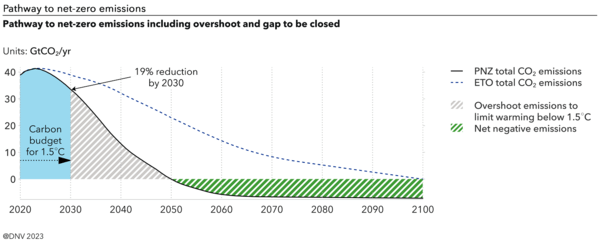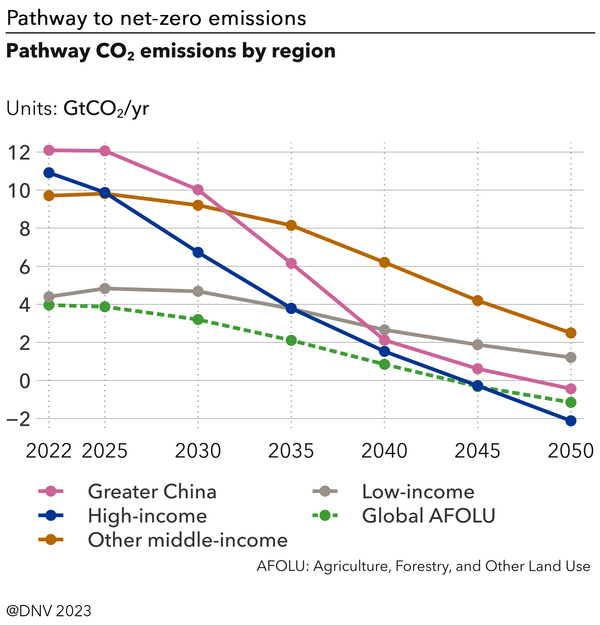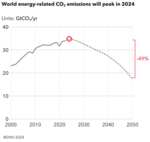News Release from DNV
Wind Industry Profile of
Pre-COP28 report: High-income countries must reach net zero way before 2050
DNV’s Pathway to Net Zero Emissions report is a companion to the Energy Transition Outlook report and depicts DNV’s most feasible route to achieving net zero emissions by 2050 and limiting global warming to 1.5°C. As CO2 emissions are expected to reach record levels in 2023 and to peak at even higher levels next year, immediate and permanent fossil fuel cuts are necessary.
Drastic CO2 reductions not enough
This must be enabled by efficient and fast oil, gas, and coal replacement by renewable electricity, hydrogen, and biofuels, but a fully fossil free energy system by 2050 is not feasible. Therefore, a massive carbon capture and removal effort is essential to compensate for the remaining CO2 emissions from fossil fuels and the unavoidable “over-shoot” of the carbon budget, which will be exhausted by 2030.
We will need to remove 6 gigatons (Gt) of emissions per year between 2050 and 2100 to achieve the 1.5°C goal. This is high risk and depends on scaling unproven technologies like direct air capture and bioenergy with carbon capture and storage, but no plausible pathway to net zero exists without removing CO2 from the atmosphere.

Image: DNV
Every action is vital
Individually and collectively, the roadmaps described in the report are possible but very tough. Nothing of this scale has ever been attempted. Their successful implementation will require substantial contributions from technology and finance, an extraordinary step-up in energy, climate, industrial and economic policies, and behavioural changes. Moreover, these changes and emission reductions must happen simultaneously.
“We have to utilise the full policy toolbox for a faster transition. There is an urgent need to rethink and establish new policies, with international cooperation ensuring ownership of actions across all regions and sectors. It is crucial to stay as far below 2°C as possible, and every action to reduce emissions and accelerate energy transition is important. At this stage, every tenth of a degree of avoided temperature increase is highly important”, says Remi Eriksen, Group President and CEO of DNV.
Different levels of scaling
While solar power and electric vehicles are scaling well, most other technologies, including hydrogen production and carbon removal, still need more and faster scaling. Electricity must reach almost 50% of the energy mix in 2050 but depends on rapid grid extensions, which are already subject to delayed permitting and supply chain bottlenecks. At the same time, energy efficiency improvements need to be doubled above current levels.
Together with wind, solar power is already the cheapest source of new electricity in most places in the world, and costs continue to fall rapidly as manufacturing capacity ramps up. According to the Pathway report, solar power can overtake oil as the largest energy source by 2040 and have a higher share than all fossil fuels combined by 2050. Solar power can overtake gas-fired electricity to become the largest source of electricity globally and from the late 2030s, solar and wind will be of equal size, totally dominating global electricity production.
Regions must reach net zero ten years earlier – and some way before 2050
Every region needs to do more and act faster. Although every region needs to exceed their current ambitions and meet these, different timelines will apply. DNV’s Pathway to Net Zero Emissions is built upon the UNFCCC's principle, stating a joint but distinct responsibility for achieving net zero. GDP per capita is the main driver for the emissions path towards 2050. All regions must achieve their net zero targets much earlier than currently planned: OECD before 2045, Greater China before 2050 and the rest of the world before 2060.

"To reach global net zero in 2050, high-income regions and leading demand sectors must move further and faster. All regions must achieve their net zero targets almost ten years earlier than stated ambitions," said Remi Eriksen, Group President and CEO of DNV.
- Source:
- DNV
- Author:
- Press Office
- Link:
- www.dnv.com/...
- Keywords:
- DNV, pathway, CO2, emissions, net zero, 2050, report, measures, energy ransition outlook, global warming
























